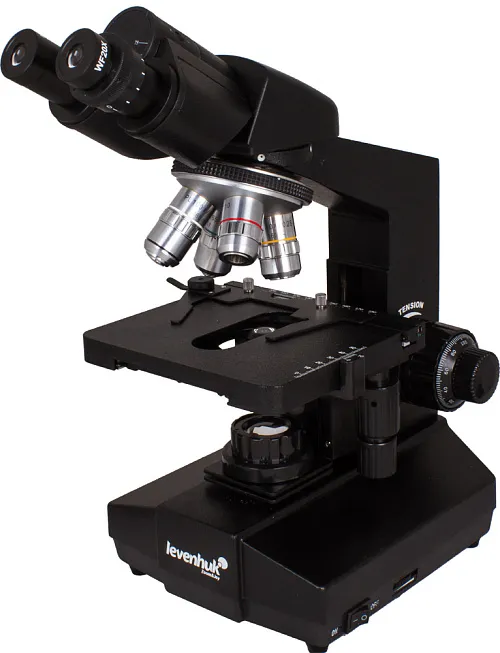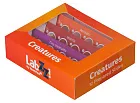Levenhuk 850B Biological Binocular Microscope - Exhibition Item
Binocular head. Revolving nosepiece: 4 objectives. Magnification: 40–2000x
| Product ID | 74719 |
| Brand | Levenhuk, Inc., USA |
| Warranty | lifetime |
| EAN | 2400000040798 |
| Package size (LxWxH) | 26x41x32 cm |
| Shipping Weight | 6.15 kg |
Special price! Further discounts or special offers cannot be applied in this case.
Exhibition copy.
This item has a mechanical defect (scratch on the microscope body).
Otherwise, the product is fully functional.
Exhibition copies cannot be exchanged or returned for a refund. Levenhuk 850B Biological Binocular Microscope is ideal for biochemical, pathologo-anatomic, cytologic, urologic, dermatologic, biologic, and general clinical research in laboratories of any medical institution. It allows examinations using the bright field method. It also features a binocular rotatable nosepiece. Its revolving head allows positioning of four objectives, is inclined at 30 degrees and rotates 360 degrees around its axis. The microscope features the classic Koehler illumination system, with field and aperture diaphragm adjustment. The focusing mechanism features integrated coarse- and fine-adjustment screws. Focus accuracy is achieved due to the vertical move of the stage relative to the fixed objective with use of focusing handles. Bi-coordinate stage can move in horizontal and vertical directions. The stage dimensions are 140x155 mm (5.5x6.1 in). The focusing mechanism and stage move smoothly, without jerks or backlash. Increment is 25 mm (1 in) for coarse focusing and 0.002 mm (0.00008 in) for fine focusing. The microscope’s illumination system includes a halogen lamp 6V/20W, with smooth brightness adjustment. Features: The kit includes: Caution: Please refer to the specifications table for the correct mains voltage and never attempt to plug a 110V device into 220V outlet and vice versa without using a converter. Remember that mains voltage in the U.S. and Canada is 110V and 220–240V in most European countries. Some things you can see under a microscope: Levenhuk 850B Biological Binocular Microscope is compatible with Levenhuk digital cameras (purchased separately). Levenhuk cameras are installed in the eyepiece tube instead of an eyepiece. The microscope comes with two additional accessories for connecting a digital camera: an extension tube and another extender. We recommend using these accessories when working with short focus objectives in order to achieve better focus.





| Product ID | 74719 |
| Brand | Levenhuk, Inc., USA |
| Warranty | lifetime |
| EAN | 2400000040798 |
| Package size (LxWxH) | 26x41x32 cm |
| Shipping Weight | 6.15 kg |
| Type | light/optical, biological |
| Microscope head type | binocular |
| Optics material | optical glass |
| Head | swivel |
| Head inclination angle | 30 ° |
| Magnification, x | 40 — 2000 |
| Eyepiece tube diameter, mm | 23.2 |
| Eyepieces | paired WF10х, WF20х |
| Objectives | planachromat: 4x, 10x, 40xs, 100xs (oil immersion) |
| Revolving nosepiece | for 4 objectives |
| Interpupillary distance, mm | 55 — 75 |
| Stage, mm | 140х150 |
| Stage moving range, mm | 70/50 |
| Eyepiece diopter adjustment, diopters | ±5 |
| Condenser | Abbe N.A. 1.25 |
| Diaphragm | premium class iris diaphragm |
| Focus | coarse: 25mm, fine: 0.002mm |
| Illumination | halogen |
| Brightness adjustment | ✓ |
| Power supply | 220V/50Hz |
| Application | laboratory/medical |
| Illumination location | lower |
| Research method | bright field |
We have gathered answers to the most frequently asked questions to help you sort things out
Find out why studying eyes under a microscope is entertaining; how insects’ and arachnids’ eyes differ and what the best way is to observe such an interesting specimen
Read this review to learn how to observe human hair, what different hair looks like under a microscope and what magnification is required for observations
Learn what a numerical aperture is and how to choose a suitable objective lens for your microscope here
Learn what a spider looks like under microscope, when the best time is to take photos of it, how to study it properly at magnification and more interesting facts about observing insects and arachnids
This review for beginner explorers of the micro world introduces you to the optical, illuminating and mechanical parts of a microscope and their functions
Short article about Paramecium caudatum - a microorganism that is interesting to observe through any microscope















